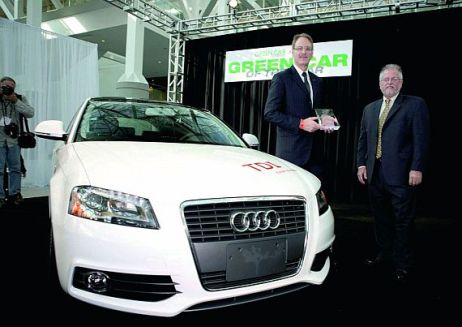 It was an Academy Award-esque shocker at the Green Car Journal’s 2010 Green Car of the Year awards on Thursday. The award, bestowed at the LA Auto Show each year, honors the vehicle that had the greatest positive impact on the environment. The 50 mpg third-generation Prius, in the eyes of many observers, certainly seemed a shoe-in for such honors.
It was an Academy Award-esque shocker at the Green Car Journal’s 2010 Green Car of the Year awards on Thursday. The award, bestowed at the LA Auto Show each year, honors the vehicle that had the greatest positive impact on the environment. The 50 mpg third-generation Prius, in the eyes of many observers, certainly seemed a shoe-in for such honors.
However, when the award was announced, it was Audi, not Toyota accepting the honors. The 2010 Audi A3 TDI, a vehicle with a clean diesel engine, took home the trophy. The sporty, yet economical car features 42 mpg highway and 32 mpg city fuel economy on a 2.0L 140-horsepower inline-4 diesel engine.
Priced from $29,950, the vehicle retails for a bit more than the Prius, but features some additional luxury touches.
The award demonstrates a logical shift in thinking for the green community that has long been missing. The thought is that while hybrids and electric vehicles, which feature smaller sales, are good, mass market vehicles are better. That sentiment was echoed in the enthusiasm green car advocates showed for small fuel-efficient vehicles at the LA Auto Show, including the Chevy Cruze, the Hyundai Sonata, Volkswagen Golf TDI, and the Ford Fiesta.
Jake Fisher, senior engineer at Consumer Reports, comments, “Cars like the Cruze and the Fiesta will certainly have a bigger impact on the environment because they will be high-volume vehicles.”
Mass market appeal seems the best way to make the largest impact. Johan de Nysschen, Audi of America’s president, who once called buyers of GM’s Chevy Volt “idiots”, emphasized this in his acceptance speech. He stated, “”Green is no longer progressive. Green is expected.”
With the new generation of fuel-efficient gasoline and diesel engines coming online, combined fuel economies in the 30 mpg to 40 mpg range can finally will be realized. If these vehicles can comprise the majority of sales, displacing vehicles with traditional fuel economies of around 20 mpg, this will lead to a third less fuel consumption and carbon emissions.
What’s great, though, is that many of these cars like the Audi A3 TDI and the Ford Fiesta seem fun to drive as well. For that reason, the 2010 Audi A3 TDI seem a befitting recipient of its Green Car of the Year honors. As Ron Cogan, the editor and publisher of Green Car Journal sums up, “The love of cars and the love of the environment are not mutually exclusive.”
Editors' Recommendations
- Audi GrandSphere concept shows how autonomy opens new design avenues
- Audi’s new A3 Sedan learns a few tech tricks from its bigger siblings
- 2020 Audi E-Tron Sportback, RS Q8 confirmed for 2019 LA Auto Show
- Audi balances carsharing, EVs, and sports cars as it prepares for the 2020s
- For Volkswagen, the electric ID.3 is more than a new car. It’s a new chapter


